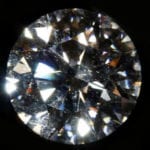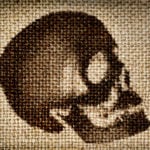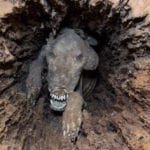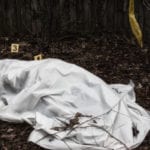 Technology
Technology  Technology
Technology  Humans
Humans 10 Everyday Human Behaviors That Are Actually Survival Instincts
 Animals
Animals 10 Animals That Humiliated and Harmed Historical Leaders
 History
History 10 Most Influential Protests in Modern History
 Creepy
Creepy 10 More Representations of Death from Myth, Legend, and Folktale
 Technology
Technology 10 Scientific Breakthroughs of 2025 That’ll Change Everything
 Our World
Our World 10 Ways Icelandic Culture Makes Other Countries Look Boring
 Misconceptions
Misconceptions 10 Common Misconceptions About the Victorian Era
 Mysteries
Mysteries 10 Strange Unexplained Mysteries of 2025
 Miscellaneous
Miscellaneous 10 of History’s Most Bell-Ringing Finishing Moves
 Technology
Technology Top 10 Everyday Tech Buzzwords That Hide a Darker Past
 Humans
Humans 10 Everyday Human Behaviors That Are Actually Survival Instincts
 Animals
Animals 10 Animals That Humiliated and Harmed Historical Leaders
Who's Behind Listverse?

Jamie Frater
Head Editor
Jamie founded Listverse due to an insatiable desire to share fascinating, obscure, and bizarre facts. He has been a guest speaker on numerous national radio and television stations and is a five time published author.
More About Us History
History 10 Most Influential Protests in Modern History
 Creepy
Creepy 10 More Representations of Death from Myth, Legend, and Folktale
 Technology
Technology 10 Scientific Breakthroughs of 2025 That’ll Change Everything
 Our World
Our World 10 Ways Icelandic Culture Makes Other Countries Look Boring
 Misconceptions
Misconceptions 10 Common Misconceptions About the Victorian Era
 Mysteries
Mysteries 10 Strange Unexplained Mysteries of 2025
 Miscellaneous
Miscellaneous 10 of History’s Most Bell-Ringing Finishing Moves
10 Weird Things We Have Found Inside Statues
Ancient statues are considered relics from the distant past. However, they sometimes contain other relics like scrolls, letters, money, or other items of historical importance.
The finds are often surprising and coincidental because nobody would expect to find such items in the statues. But as we are about to find out, the items are often deliberately hidden inside.
10 Two Letters Were Found In The Buttocks Of A Statue Of Jesus
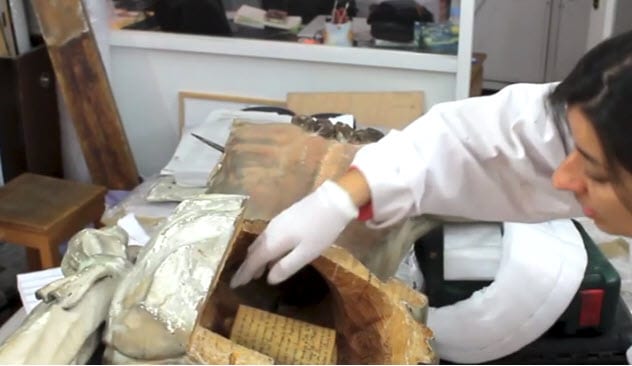
A few years ago, two letters were found hidden inside the buttocks of a 240-year-old statue of Jesus in St. Agueda, Spain. After a preservationist made the discovery, the team removed a part of the sculpture to reveal two notes inside the buttocks.
The notes were written in 1777 by Joaquin Minguez, a clergyman at the Burgo de Osma cathedral in Spain. Minguez wrote that the statue was made by Manuel Bal, who also made similar sculptures for other cathedrals. Minguez added that they had successfully harvested wheat, rye, oats, and barley that season and had lots of wine in storage.
He also wrote that typhoid had plagued their village and they often played ball and cards to while away the time. He added that King Carlos III reigned at that time and his palace was in Madrid. The church that owned the statue had the letters duplicated. The originals were sent to the Archbishop of Burgos to be archived, while the copies were returned to the buttocks.[1]
9 The Skeleton Of A Self-Mummified Monk Was Found Inside A Buddha Statue
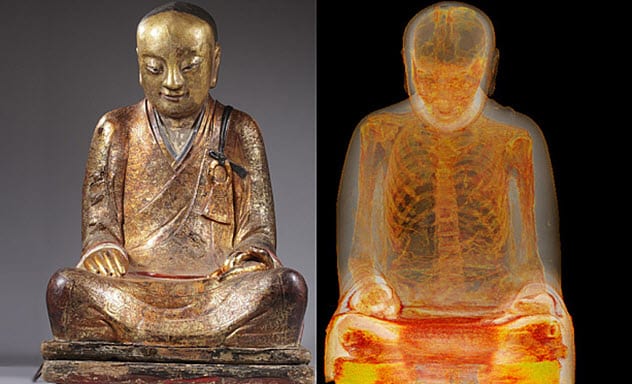
In the 1990s, the statue of a Buddha was discovered to contain the real skeleton of a monk. Apparently, the monk self-mummified sometime in the 10th century. His remains were later turned into a statue.
Self-mummification is peculiar to Buddhists. It refers to a deliberate act by monks to turn themselves into mummies as they slowly died. The process is long and arduous. In fact, it begins three years before death. First, the monks adopt a tree-eating diet. That is, they only feed on nuts, roots, berries, and bark.
Between 1,000 and 3,000 days later, they begin what is called nyujo. They stop eating and only drink water mixed with salt as they slowly meditate to death. They are buried alive at the brink of death. Their remains are later exhumed to confirm if they have decayed or turned into a mummy.
Such mummies are rare and one in a statue is even more unusual. In fact, the body of the Buddha we mentioned earlier is the only known example of self-mummification inside a statue.
After he died, his mummified remains were displayed in a temple for two more centuries. However, the body slowly disintegrated, prompting some monks to encase it in a statue. The skeleton could not be analyzed over fears that it could disintegrate if removed. However, an X-ray revealed that the skeleton was in perfect condition.[2]
8 Ancient Money Found Inside Ancient Chinese Statue
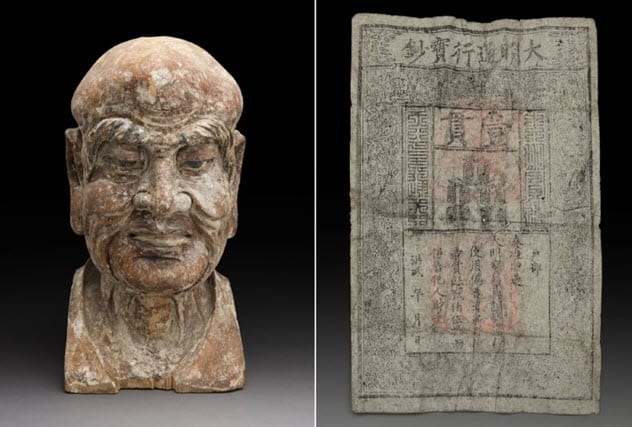
In 2016, Australian art experts discovered an ancient banknote inside the hollowed head of a 645-year-old wooden statue of a Chinese Buddha. The banknote was the size of a standard letter, making it larger—and weirder—than today’s bills.
Writings on the paper indicated that it was issued in 1371. This was during the reign of Zhu Yuanzhang, the first emperor of the Ming dynasty. The banknote was valued at one guan, equivalent at the time to 1,000 copper coins or 28 grams (1 oz) of silver.
Writings on the banknote encouraged citizens to report counterfeiters, who were threatened with decapitation. Nevertheless, this rare specimen is one of the earliest banknotes ever made. This type of cash was almost exclusive to China in 1371. Europe still used coins and slowly switched to banknotes about 300 years later.
Interestingly, the discovery was only made by chance. The statue was being prepped for auction when the banknote was found. Curiously, neither of its two previous owners managed to find the bill. The banknote was later listed for auction.[3]
7 Statue Of Jesus Discovered To Contain Human Teeth
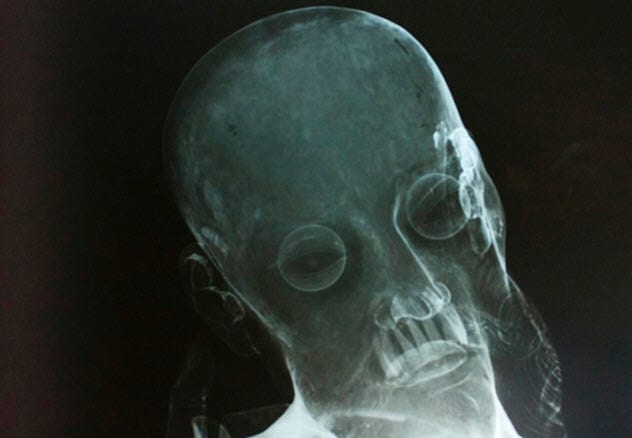
In 2014, a wooden statue of Jesus was undergoing restoration in Mexico when it was discovered to contain real human teeth. The statue was called Christ of Patience and depicted Jesus as he awaited crucifixion. He is bloodied and seated as he awaits his fate.
Preservationists do not know how the 300-year-old statue ended up with real human teeth. In truth, old statues from that region of Mexico often have real nails, teeth, and hair. We have found a statue of baby Jesus with two small rabbit teeth, a statue of a devil with dog teeth, and several other statues with real human hair.
However, a statue with real human teeth was unheard-of. The chompers were in perfect condition, which sort of makes the whole thing weird. The mouth of the statue was always closed, making the teeth almost impossible to see. In fact, preservationists only discovered them while taking an X-ray of the statue.
Preservationists suspect that the teeth were taken from a living or dead worshiper who wanted them donated to the church. Mexican Christians often donated body parts to churches in the 17th and 18th centuries. Alternatively, the teeth could have been forcibly taken from somebody who did not want to donate them.[4]
6 Cocaine
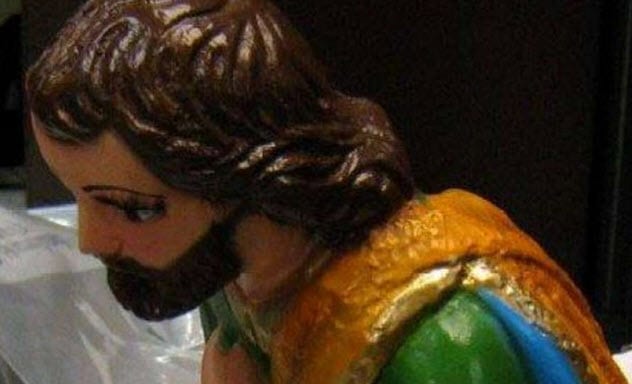
Drug smugglers need to be innovative to remain in business. This has seen them inventing all sorts of strange methods to evade detection, such as hiding drugs inside statues. A more radical method is to make sculptures from drugs.
In 2010, police in Colombia recovered a World Cup replica made with cocaine just before it was shipped out of Bogota airport to Spain. The statue was made with 11 kilograms (24 lb) of cocaine mixed with either acetone or gasoline so that it could be molded.
In the United States, a statue of Jesus was seized during transportation from Mexico to Dallas, Texas. The sculpture contained 3 kilograms (6 lb) of cocaine and several other unidentified materials so that the figure could be molded. Sniffer dogs uncovered the plot.[5]
5 Keys And Love Letters Found Inside A Statue Of Juliet
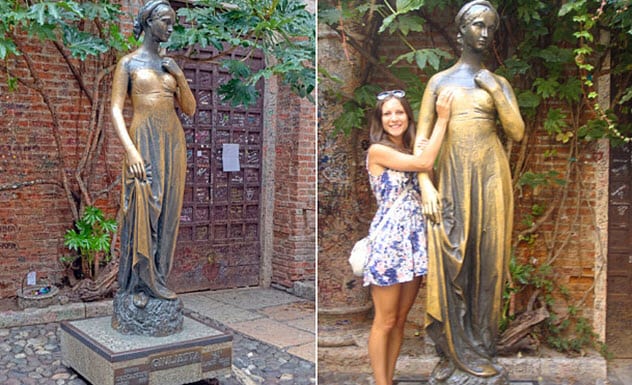
A few years ago in Verona, Italy, a bronze statue of Juliet—Romeo’s love in the Shakespearean tragedy Romeo and Juliet—was discovered to contain hundreds of keys and love letters. The items were detected during a restoration around Valentine’s Day in 2015.
The statue was sculpted in 1969 and was installed in Verona because it is considered the hometown of the fictional Juliet. However, the sculpture has slowly deteriorated as tourists often rubbed the breasts and arms for good luck. This caused it to wear and, ultimately, crack.
Soon, tourists began to insert love letters through these cracks into the hollow interior of Juliet. There were also lots of keys because lovers sometimes wrote their names on small padlocks before throwing or hiding the keys somewhere. The keys and letters were only discovered when preservationists tried sealing the cracks and creating a duplicate of the statue.[6]
4 Confederate Flags, Newspapers Clippings, And Confederate Currency Found Inside A Controversial Confederate Statue
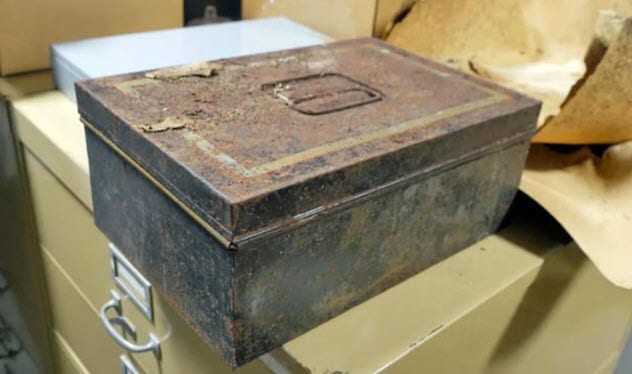
For years, a 363-kilogram (800 lb) statue of a Confederate soldier called Johnny Reb stood in Orlando, Florida. The statue became controversial and was widely condemned for being racist and a symbol of white supremacy. This controversy culminated in its removal in 2017.[7]
At that time, a small metal box was discovered hidden at the base of the statue. The box was later revealed to contain newspaper clippings, Confederate flags, and Confederate dollar bills. The statue itself was moved to a cemetery and installed near the graves of 37 Confederate soldiers.
3 Letters, Newspaper Clippings, Photographs, And Autographs Found Inside Statue
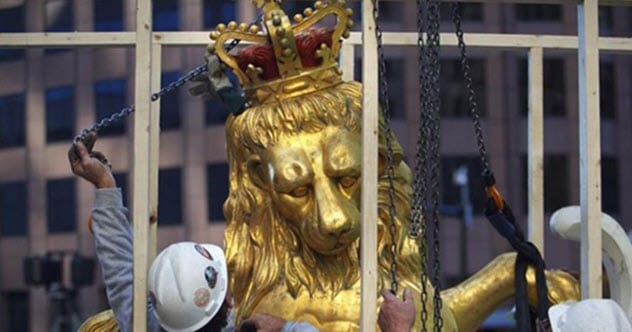
In 2014, the statue of the golden lion atop the Old State House in Boston was discovered to contain a time capsule. It was found in the head of the lion as the sculpture was removed for renovation.
Interestingly, the time capsule was not always forgotten. Its existence was reported in The Boston Globe in 1901. However, the time capsule was soon forgotten and only remembered when a descendant of the statue’s sculptor found a letter written by the artist. The letter mentioned the existence of the capsule and listed its contents.
According to the letter, the capsule contained newspaper clippings, photographs, and autographs. There were also several letters written by Boston politicians and residents. Boston city officials intend to make duplicates of the statue’s contents and put them in the statue along with some newer items so they can be discovered again in the 22nd century.[8]
2 Scrolls Found Inside Buddhist Statue
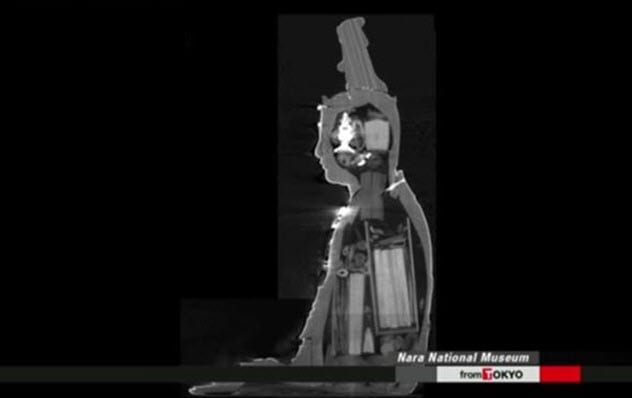
In May 2018, it was reported that a 700-year-old, 76-centimeter-tall (30 in) Bodhisattva statue at Hokkeji Temple in Nara, Japan, was discovered to contain 180 items. The statue was of Monju Bosatsu, Bodhisattva of wisdom.
Monjus are often depicted as a human seated on a lion. The human holds a Buddhist book in one hand and a sword in the other. Sitting on a lion depicts the fact that the human has tamed their mind. The literature signifies knowledge, and the sword shows they have “cut through ignorance.”
The 180 items included scrolls, relics, and other unconfirmed artifacts. Thirty were found in the head, and the other 150 were inside the body. However, we cannot confirm the contents of the scrolls because the discovery was made during a CT scan. The statue itself remains sealed.[9]
1 A Gold Statue Is Found Inside Another Statue
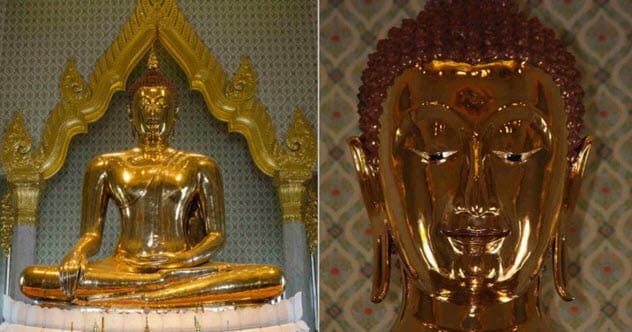
Phra Phuttha Maha Suwan Patimakon is a 2.7-meter-tall (9 ft) Buddha statue in Bangkok, Thailand. The sculpture used to be covered in stucco, giving it an appearance of a worthless artifact. It is believed to have been sculpted in India sometime between the 13th and 14th centuries.
The statue arrived Bangkok in 1801 and was displayed in a temple of Wat Chotanaram. It was later moved to Wat Traimit in 1935. However, the sculpture was so huge—and worthless—that it was left outside the temple for years. Only a tin roof protected it from the elements.
In 1955, the statue fell as it was about to be transported to another temple in Bangkok. The stucco plaster covering it cracked, revealing parts of the gold statue inside. Workers removed the remaining stucco to reveal the 18-carat gold within.
The gold statue was made in nine parts. There was also a key so that the parts could be dismantled for transportation. Historians believe that the statue was covered with stucco to hide it from the invading Burmese in the 17th century. The plan worked. The invaders abandoned the statue because they thought it was worthless.[10]
Read more bizarre statue stories on 10 Statues That People Like To Touch In Inappropriate Places and 10 Straight-From-Hell Statues You Can’t Unsee.
